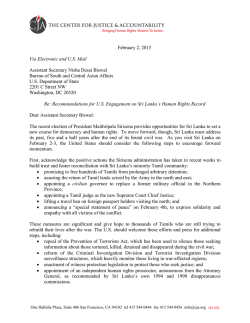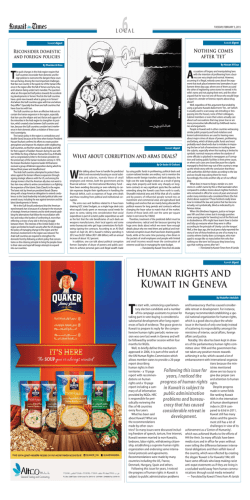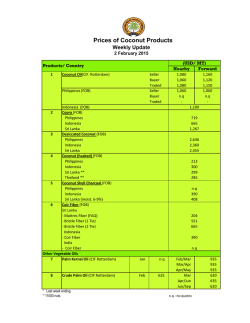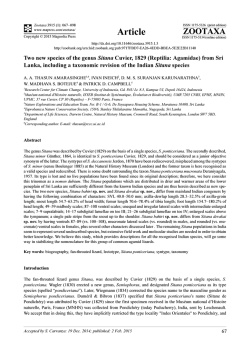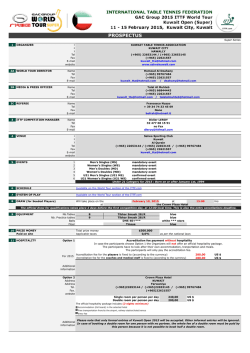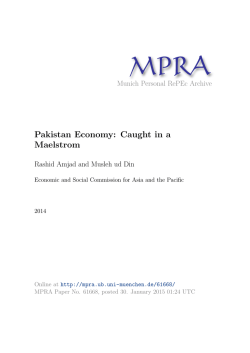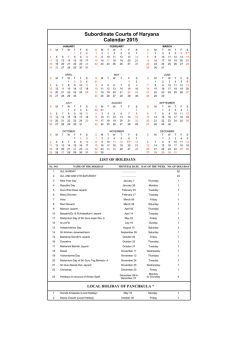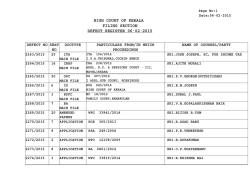
p17 2_Layout 1
p17 2_Layout 1 2/2/15 8:52 PM Page 1 TUESDAY, FEBRUARY 3, 2015 S P ORTS Kuwaiti shooters top KSSC tourney By Abdellatif Sharaa KUWAIT: Kuwait Shooting Sports Club organized Kuwait Sporting Shooting Championship, on the heels of HH the Amir 4th Annual International Grand Prix at Sabah AlAhmad Olympic Shooting Complex. The Championship saw Kuwaiti shooters dominate in all events. Shooter Jasim Al-Raihan won first place in the professionals category, followed by Fahad Lafi Al-Mutairi and Mansour Al-Rashidi was third, UAE’s Marwan Al-Amiya emerged fourth, Saud Al-Rashidi fifth and Mohammad Nayef Al-Daihani sixth. In the women’s category, Kuwait’s shooter Afrah Adel Abdelrahman took first place, followed by Sarah Abdelrahman Al-Hawal and Iman Al-Shamma. In the pioneers category, Eng Duaij Khalaf Al-Otaibi, the President of the Arab and Kuwait Shooting Federations snatched first place following a friendly competition with Masoud Jouhar Hayat, who is one of the founders of Kuwait Shooting Club and supporter of Kuwait shooters. Al-Otaibi hit 44 targets while Hayat hit 43 out of 50. Hussam Al-Roumi took place after hitting 40 out of 50 targets. The competitions were carried out according to the rules of international federations for sporting shooting located in Paris. The championship was supervised by technical experts from Belgium and Portugal, while Kuwaiti referees officiated. Kuwait Shooting Sport Club prepared and designed a special international range for this sport, and is among the best range in the world. Asia confident of shift at World Cup Brandt Snedeker Technical focus bad for Snedeker’s putting touch SCOTTSDALE: If proof was ever needed for the average club hacker that even the very best players can struggle in golf, then look no further than at putting maestro Brandt Snedeker. Widely viewed as one of the game’s leading putters over the past eight years, the fast-talking American has recently been struggling on the greens after clouding his mind with too much focus on technique. A six-times winner on the PGA Tour, Snedeker has not triumphed on the U.S. circuit since the 2013 RBC Canadian Open and he fell short of his customary high standards last season when he made 20 of 25 cuts but posted only three top-10s. “Obviously my game hasn’t been anywhere near where it needs to be,” the fast-talking American told Reuters at the Waste Management Phoenix Open where he is playing his fifth event of the 2014-15 season. “But I feel like after making a change last year to (swing coach) Butch Harmon that my game is a lot better now than it has been for the last year-and-a-half. The thing that has been holding me back is my putting, I haven’t been putting any good. “I kind of made some changes that are really, really star ting to come through and I feel like I’m on the right path. I just need to see some (putts) go in. You see some go in and everything changes.” Snedeker is not only renowned for his extraordinary putting touch but also for his old-style ‘pop’ stroke which is made with minimum of fuss in relatively fast fashion. PERFECT TECHNIQUE However, having long been an everpresent at the top of the PGA Tour’s putting charts, Snedeker has dropped well down the pecking order over the past year mainly due to a fixation with perfect technique. “I’ve kind of gotten away from what I do and trying to put a perfect stroke on every putt is not the way I putt,” said the 34-year- old from Nashville, who carded a one-under-par 70 in the opening round at the TPC Scottsdale. “I kind of got too much into that, making sure my stroke is on plane and path and everything is good instead of getting back into reading putts and just hitting them. “So I’m getting more back into that and seeing some good results and seeing what I want to see out there. I just need to see a couple go in, see a couple go in and it comes right back so I’m not too worried about it.” Snedeker, who clinched the PGA Tour’s FedExCup title in 2012, led the Tour’s ‘strokes gained over the field’ putting statistic that year and was placed fourth in that area in 2013. However last year, he dropped to 27th in strokes gained while this season he is surprisingly languishing in 110th spot. “The putts outside 10 feet will come,” Snedeker said. “Inside 10 feet, I’ve been struggling with those five, six, seven-footers, which you need obviously to make to shoot a good number.”—Reuters NEW DELHI: Conventional wisdom says Asian teams usually succumb on the bouncy wickets of Australia or the seaming pitches in New Zealand, making them vulnerable and rank outsiders for the World Cup. Co-hosts Australia and New Zealand, alongside the mighty South Africa, are the bookmakers’ favorites to win one-day cricket’s biggest prize, with Asian teams way down in the pecking order. But those already writing off Asia’s big three-India, Pakistan and Sri Lanka-will do so at their own peril. And not just because of the unpredictable nature of the limited-overs game. The only other time the tournament was held Down Under, in 1992, it was Pakistan which won the title beating England by 22 runs in the final at the Melbourne Cricket Ground. Australia did not even make the knock-out rounds, while the Kiwis, like the South Africans, crashed out in the semi-finals. Home advantage clearly does not count for much. Defending champions India are the only team to have won the World Cup on home soil, while Sri Lanka won it in Pakistan as co-hosts of the 1996 event. Barring major upsets, like in 2007 when India and Pakistan were knocked out in the first round, Asia should have three teamseven more if Bangladesh, Afghanistan or the United Arab Emirates cause an upset-in the quarter-finals. After that, three victories will ensure a team the title-a task easier said than done but one that gives the eight qualifiers a reasonable shot at the title. Kapil Dev, under whom India won its first World Cup in 1983 by shocking overwhelming favourites West Indies at Lord’s, said picking a winner was not easy. “Once you enter the quarter-finals, anything can happen,” Dev told AFP. “Every team has a chance, including the ones from Asia. It all depends on how you play on that day. “But if a side has to have an off-day, it better be during the first round where one can recover. Can’t afford that in the knock-outs.” In 2011, India and Sri Lanka finished second in their respective groups and yet entered the final as pool A winners Pakistan fell in the semi-finals and pool B leaders South Africa went out in the quarter-finals. While India, Pakistan and Sri Lanka have the batting to take on the rest, much will depend on how their meagre bowling resources are able to contain the opposition. Sri Lanka, finalists on the last two occasions, boast the top three run-getters in one-day cricket among those still playing in Kumar Sangakkara, Mahela Jayawardene and Tillakaratne Dilshan. Sangakkara and Jayawardene, members of an exclusive club of five batsmen with more than 12,000 one-day runs, are in top form to raise hopes of making their last World Cup appearance a memorable one. World bowling recordholder Muttiah Muralitharan believes this could be Sri Lanka’s World Cup after coming so near in 2007 and 2011. “We have been just about the most consistent side around in major tournaments over the past decade, regularly reaching semi-finals and finals,” Muralitharan told the tournament’s official website. “I have faith this group of players can achieve the dream again and I hope they have that faith too.” Pakistan, faced with bowling suspensions of Saeed Ajmal and Mohammad Hafeez due to faulty actions, will look to make amends through their batting which includes captain Misbah-ul Haq, Younis Khan and Shahid Afridi. “If we play to our potential, we can win,” said Misbah, whose 56-ball hundred against Australia last year equalled Viv Richards’ record for the fastest Test century. “The boys are focused on achieving the best result. They have the hunger and passion to work for it.” In Rohit Sharma, the only batsman with two 200s in one-day internationals, Virat Kohli, Suresh Raina and skipper Mahendra Singh Dhoni, India possess destructive batting firepower to tame the best attacks. “Never write India off, they will always be formidable in oneday cricket,” said former skipper Sourav Ganguly. “This side is capable of repeating 2011.”—AFP PERTH: England’s Stuart Broad bowls a delivery during a training session in Perth. —AP
© Copyright 2025
